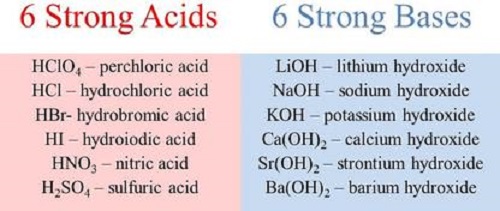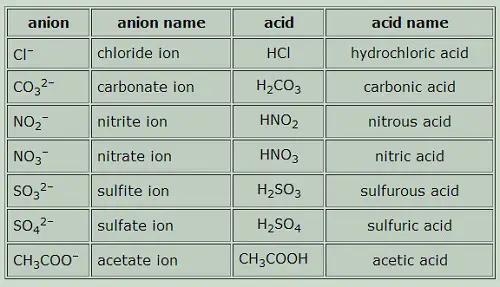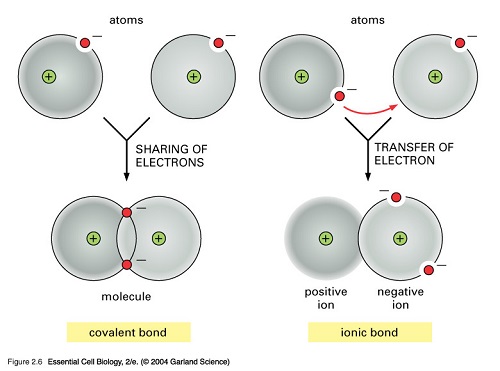What are Acids?
An acid is a molecule that is able to donate a proton (or a H+ ion). Another definition that is often used as well is that an acid is a molecule which is capable of forming a covalent bond with an electron pair – the so-called Lewis acid. There are many other terminologies and definitions, but they’re all used to describe the same thing – a molecule that, when dissolved in water, makes the resulting substance’s pH lower than 7. The pH represents the amount of free protons, or hydronium ions, present in a substance. It’s a negative correlation, so, the higher the pH, the smaller the amount of free protons. There are various ways of detecting the acidity of a substance. Litmus paper is probably the most famous one, as it’s a part of many primary-school experiments. When it comes in contact with an acid, the litmus paper would turn into a pinkish-red shade, indicating the different levels of acidity (different values of pH) with different shades. Another common indicator is phenolphthalein, a molecule which turns orange in acidic solutions, and purple in basic solutions. There are, of course, many other indicators, however they all serve the same purpose. Some common examples of acids would be the hydrochloric acid (HCl) and sulfuric acid (the one used in car batteries).

What are Bases?
Bases are somewhat complementary to acids, since they are molecules that are able to absorb a proton or a hydronium ion, usually from an acid or an acidic substance. The pH of basic substances is lower than seven. When interacting with an acid, a base will form salt. When they come in contact with the above-mentioned litmus paper, they color it blue, and phenolphthalein purple. They always contain a partially or fully displaceable OH– ions. Some common examples of bases would be the sodium hydroxide (NaOH) and the calcium hydroxide (Ca(OH)2).
Similarities between Acids and Bases
The first and main similarity is a pretty obvious one – they’re both chemical compounds. Apart from that, the similarities aren’t numerous:
- Similarities between Acids and Bases in terms of Chemical compounds:
They’re both chemical compounds
As I just stated, this is the most obvious similarity, both acids and bases are a very basic chemical compound used in many situations.
- Similarities between Acids and Bases in terms of Electrolytes:
They’re both electrolytes
This means that both acids and bases can conduct electrical current, especially when they’re given as a water solution.
- Similarities between Acids and Bases in terms of Indicators:
They both react with indicators
Indicators are tools used to determine a substance’s acidity. This is done by various different mechanisms, depending on the indicator at hand. Most follow a similar principle though – they react in different ways depending on how many hydronium ions there are, or aren’t. If there’s an abundance of them, then that means it’s a highly acidic substance – litmus paper would be colored red, while phenolphthalein would interact and become orange. If, on the other hand, the substance lacks in the amount of hydronium ions, then it’s a basic substance, the litmus paper would be colored blue and phenolphthalein purple.
- Similarities between Acids and Bases in terms of Solubility
They’re both water-soluble
Both acids and bases can be dissolved in water.
- Similarities between Acids and Bases in terms of Salt Formation:
They form salts with each other
A reaction between an acid and a base will result in the production of different salts.
Summary Points on Similarities between Acids and Bases
Acids and bases have many everyday uses. Vinegar is an acid, for example, and baking soda is a salt produced as a result of a reaction between an acid and a base. Acids are distinguished from bases by their ability to donate a proton, while bases absorb it. This makes these two molecules perfect complimentary pairs in reactions. Both acids and bases can be dissolved in water, so they’re given as water solutions in many situations, to make it easier to use them. Whether a solution is acidic or not can be found by using indicators – chemical compounds that produce visibly different results depending on the acidity. The two most common examples are litmus paper and phenolphthalein, which indicate the presence of an acid or a base by changing their color.
Author: Dr. Howard Fields
Dr. Howard is a Clinical Psychologist and a Professional Writer and he has been partnering with patients to create positive change in their lives for over fifteen years. Dr. Howard integrates complementary methodologies and techniques to offer a highly personalized approach tailored to each patient.











Leave a Reply